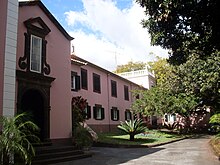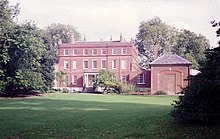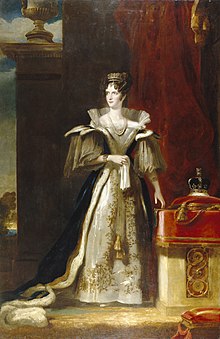Adelheid of Saxony-Meiningen (1792–1849)

Adelheid Louise Theresa Caroline Amelia von Sachsen-Meiningen , later: Queen Adelaide (born August 13, 1792 in Meiningen , † December 2, 1849 in Bentley Priory near Stanmore , Middlesex ), was a German princess and from 1830 Queen of Great Britain and Ireland as well Queen of Hanover .
Adelheid gave their names to the Australian city of Adelaide , the South African city of Adelaide and the German municipality of Adelheidsdorf .

Life
Childhood and youth

Princess Adelheid of Saxony-Meiningen was born in Meiningen, the capital and residence of Saxony-Meiningen , in 1792 as the daughter of Duke George I of Saxony-Meiningen and his wife Princess Louise Eleonore zu Hohenlohe-Langenburg . She was the first child in her parents' ten-year marriage. Two years later, Adelheid's sister Ida followed, and in 1800 the brother and heir to the throne Bernhard .
When Adelheid was eleven years old, her father died in 1803 and her mother Louise Eleonore took over the reign of the country. The years of the Napoleonic Wars were full of hardship for the ducal family. Adelheid looked after billeted soldiers with her sister and mother. She received a comprehensive and excellent education, spoke several foreign languages and showed an interest in literature, music and painting. In 1816 her sister Ida, who she was very close to her life, married Duke Bernhard von Sachsen-Weimar , and two years later Adelheid's engagement was announced.
The engagement
Adelheid became engaged to Wilhelm Heinrich of Great Britain, Duke of Clarence , on April 19, 1818 . The bridegroom had a few flaws, however; already 53 years old, he had ten children from a longstanding relationship with his mistress, actress Dorothy Bland . The couple had separated in 1811 and Dorothy had died impoverished in France in 1816. Wilhelm was considered to be moderately educated and was only called "Silly Billy" by his compatriots. Therefore, Queen Charlotte had to intervene in the bride show. The proper marriage of Wilhelm and his brothers was of some political importance, because despite the many sons of George III. there was no legitimate heir to the throne.
Saxony-Meiningen had to go deep into debt for Adelheid's enormous dowry, and further annual donations were planned for the personal needs of the princess. The bride traveled to England on June 20, 1818, accompanied by her mother, and was initially only received by one of Wilhelm's illegitimate sons. She made a far better impression on Queen Charlotte than on her son.
Duchess of Clarence
On July 13, 1818, Adelheid and Wilhelm were married in the Queen's apartments at Kew Palace , Surrey. It was a double wedding, because Wilhelm's younger brother Eduard also married the widowed Victoria von Sachsen-Coburg-Saalfeld on that day , whose daughter Victoria would later become Wilhelm's successor.
Shortly after the wedding, the couple began a trip to the continent and lived for some time at the court in Hanover . Here Adelheid gave birth to her first child, a premature baby, on March 27, 1819. Little Princess Charlotte Augusta unfortunately only lived a few hours. At the end of September 1819, the Duke and Duchess returned to England after Adelheid had suffered a miscarriage in Calais . Immediately after her arrival, she and her husband went on a spa tour through the seaside resorts of England.
After that, both lived in their London domicile Clarence House , only to retreat to Bushy Park for several years , where Wilhelm had already lived with Dorothy Bland. The duchess, who was very fond of children, looked after the duke's children and developed a strong affection for her niece Victoria . On December 10, 1820, Adelheid became the mother of a daughter again. Also born prematurely, Princess Elisabeth died three months later.
In 1822 and 1825 Adelheid and Wilhelm again traveled the continent to France, Belgium and Germany. Each time they were guests in Meiningen. Prince Frederick, Duke of York and Albany died in 1827 . Wilhelm was now the next heir to the throne, and the Bushy Park couple attracted more public interest. In 1829 Adelheid took over a third of the cost of building the first Meiningen theater . King George IV died on June 26, 1830 .
queen
Wilhelm, Duke of Clarence, succeeded his brother as King Wilhelm IV in 1830. He was already 65 years old, his wife, now Queen Adelaide, 38.
Adelaide initially stayed in Bushy Park, only partially taking part in her brother-in-law's funeral services. The family-oriented queen was completely apolitical, took care of her husband and his numerous children and grandchildren. The royal court was considered simple, humble and boring. The coronation celebrations cost only a fifth of the amount that George IV had spent on the occasion.
Although the Queen stayed away from politics, she was the center of criticism after the failure of the reform with her conservative attitude towards the right to vote. At the height of the campaign, the Morning Chronicle vilified the Queen as an "ugly German woman". In 1834 she returned to her home in Meiningen to see her relatives, which was very beneficial for the Queen's mental state.
Adelheid was also blamed for the failure of the Whig government in 1834, and on November 15, 1834 , the Times described the Queen as reactionary, dominant, an enemy of the people and, on top of that, ugly.
In 1837 King Wilhelm IV fell ill and had to sit in a wheelchair. Adelheid looked after her husband until he finally died on June 20, 1837.
Queen widow

After Wilhelm's death, Adelheid moved from Windsor Castle back to Bushy Park and withdrew into private life. She was the first Queen Dowager in Great Britain in over a century and would outlive her husband by twelve years. At the end of the 1830s, Adelheid took over part of the cost of building Landsberg Castle in Meiningen and had the plans drawn up by the English architect Sir Jeffry Wyatville.
A year after Wilhelm's death, she toured the Mediterranean on a cruise. In Malta , she founded the Church of St. Paul in Valletta from her private funds in 1839 . In 1844 she traveled back to her homeland in Germany. She spent the last two years of her life in Madeira . She lived there in the Quinta Vigia in Funchal .
In 1848, already seriously ill, she moved back to England and took up residence in Bentley Priory near Stanmore outside London, where Queen Victoria and Prince Consort Albert often visited her. On December 2, 1849, Adelheid died in Bentley Priory in the presence of the Queen and her siblings. The funeral, which Adelheid wanted to keep as simple as possible, took place in Windsor. Queen Victoria was hit hard by this death: she and Adelheid had been closely connected since Victoria's childhood. Victoria also named her first child Victoria Adelaide in her honor .
progeny
- Charlotte Augusta Louisa (* / † March 27, 1819 in Hanover )
- Elizabeth Georgiana Adelaide (born December 10, 1820 in St James's Palace , † March 4, 1821 in St. James's Palace)
- Twin sons (* / † 1822)
- Twin pair (* / † 1824)
ancestors
| Adelheid of Saxe-Meiningen |
Father: Georg I, Duke of Saxe-Meiningen |
Grandfather: Anton Ulrich, Duke of Saxony-Meiningen |
Great-grandfather: Bernhard I, Duke of Saxony-Meiningen |
|
Great-grandmother: Elisabeth Eleonore, Princess of Braunschweig-Wolfenbüttel |
|||
|
Grandmother: Charlotte Amalie, Countess of Hessen-Philippsthal |
Great-grandfather: Karl I, Landgrave of Hessen-Philippsthal |
||
|
Great-grandmother: Christine, Princess of Saxony-Eisenach |
|||
|
Mother: Louise Eleonore, Princess of Hohenlohe-Langenburg |
Grandfather: Christian Albrecht, Prince of Hohenlohe-Langenburg |
Great-grandfather: Ludwig, Prince of Hohenlohe-Langenburg |
|
|
Great-grandmother: Eleonore, Countess of Nassau-Saarbrücken |
|||
|
Grandmother: Caroline, Princess zu Stolberg-Gedern |
Great-grandfather: Friedrich Carl, Prince of Stolberg-Gedern |
||
|
Great-grandmother: Louise, Countess of Nassau-Saarbrücken |
title
- 1792–1815: Your Highness Princess Adelheid of Saxony-Meiningen, Duchess of Saxony
- 1815–1818: Her Highness Princess Adelheid von Sachsen-Meiningen, Duchess in Saxony
- 1818-1830: Her Royal Highness The Duchess of Clarence and St Andrews
- 1830–1837: Her Majesty The Queen (of the United Kingdom and of Hanover)
- 1837–1849: Her Majesty Queen (Dowager) Adelaide
Trivia
Named after Adelaide are the capital of the state of South Australia in Australia , Adelaide , the Adelaide River in Australia, Queens Park in Brighton , Adelaide Avenue in Canberra , which is the official residence of the Australian Prime Minister, Adelaide Street in Toronto , the place Adelaide in South Africa and the Adelaide island - a 120-km long and 30 km wide island off the west coast of the Antarctic peninsula .
A colony still in the making on the Chaussee from Hanover to Celle , later Bundesstrasse 3 , was also given the name Adelheidsdorf in honor of Queen Adelheid by order of the Cabinet Ministry of Hanover on February 14, 1831 .
Adelheid is said to have introduced the custom of the Christmas tree , which is well known in her home country, as well as the tradition of giving Christmas presents in Great Britain.
In the Meiningen museums in Elisabethenburg Castle, a permanent exhibition is dedicated to the life of Adelheid in the former living quarters of her childhood and youth.
literature
- Matthias Blazek: "Adelheid - Princess of Saxony-Meiningen", in: Matthias Blazek, Wolfgang Evers: Villages in the shadow of the Müggenburg . Self-published, Adelheidsdorf 1997, p. 9 ff.
- Matthias Blazek: "Adelheid von Sachsen-Meiningen / namesake of Adelheidsdorf and Adelaide - later Queen of England remains childless and has probably never been in the Celler area", Sachsenspiegel 45, Cellesche Zeitung of November 10, 2012
- Alfred Erck, Hannelore Schneider: “The Meininger on the English throne”, in: Meininger Heimatklänge , Meininger Mediengesellschaft (Ed.), Edition 12/1999
- Alfred Erck, Hannelore Schneider: The Meiningerin on the English royal throne. The fate of women during the first half of the 19th century . Bielsteinverlag, Meiningen 2005 ISBN 3-9809504-0-9
- Marjorie Hoare: The Quintas of Madeira. Windows into the past . Funchal 2004. p. 239 ISBN 972-9177-38-4
- Marita A. Panzer: England's Queens - From the Tudors to the Windsors . Pustet, Regensburg 2001 (special edition: Piper Verlag, Munich 2008) ISBN 978-3-492-23682-9
- Alvin Redman: On England's Throne: The House of Hanover - The House of Hanover . London 1960, Munich 1961
- David Williamson: The National Portrait Gallery History of the Kings and Queens of England . London 1998 ISBN 978-1-56852-279-1
Web links
- Detailed biography of Adelheid von Sachsen-Meiningen. Archived from the original on July 5, 2007 ; Retrieved May 29, 2005 .
- Literature by and about Adelheid von Sachsen-Meiningen in the catalog of the German National Library
Individual evidence
- ↑ Adelaide was founded on December 28, 1836 by Colonel William Light at the foot of Mount Lofty and incorporated in 1843. The place, founded as the capital of the English colony of South Australia , was named after the reigning British Queen at the express request of King Wilhelm IV. The construction of the first houses began in March 1837. Cf. German-American Conversations-Lexicon, Volume One, edited. v. Alexander J. Schem, New York 1869, p. 113. Adelaide is the only Australian capital that has been named after a woman.
| predecessor | Office | successor |
|---|---|---|
| Caroline of Braunschweig |
Queen Consort of the United Kingdom of Great Britain and Ireland 1830–1837 |
Albert of Saxe-Coburg and Gotha |
| Caroline of Braunschweig | Queen of Hanover 1830–1837 |
Friederike von Mecklenburg-Strelitz |
| personal data | |
|---|---|
| SURNAME | Adelheid of Saxe-Meiningen |
| ALTERNATIVE NAMES | Adelaide; Adelheid Louise Theresa Caroline Amelia |
| BRIEF DESCRIPTION | Princess of Saxe-Meiningen and by marriage Royal Consort of England |
| DATE OF BIRTH | August 13, 1792 |
| PLACE OF BIRTH | Meiningen |
| DATE OF DEATH | December 2, 1849 |
| Place of death | Bentley Priory at Stanmore (London) , Middlesex |






